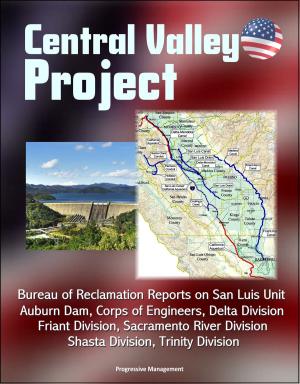21st Century Guide to Carbon Sequestration: Capture and Storage to Fight Global Warming and Control Greenhouse Gases, Carbon Dioxide, Coal Power, Technology Roadmap and Program Plan
Nonfiction, Science & Nature, Science, Biological Sciences, Ecology| Author: | Progressive Management | ISBN: | 9781458058232 |
| Publisher: | Progressive Management | Publication: | February 24, 2011 |
| Imprint: | Smashwords Edition | Language: | English |
| Author: | Progressive Management |
| ISBN: | 9781458058232 |
| Publisher: | Progressive Management |
| Publication: | February 24, 2011 |
| Imprint: | Smashwords Edition |
| Language: | English |
Carbon sequestration, one of the most promising ways for reducing the buildup of greenhouse gases in the atmosphere, is comprehensively covered in this up-to-date guide about ongoing research and development plans. It includes the Carbon Sequestration Technology Roadmap and Program Plan, Ensuring the Future of Fossil Energy Systems through the Successful Deployment of Carbon Capture and Storage Technologies, U.S. Department of Energy. CO2 capture is the separation of CO2 from emissions sources or the atmosphere. From emissions sources, CO2 is recovered in a concentrated stream that is amenable to sequestration or conversion. Issues covered here include: geologic formation usage; terrestrial ecosystems; monitoring, verification, and accounting; simulation and risk assessment; Regional Carbon Sequestration Partnership; systems and analysis; avoided emissions; stabilization of CO2 in the atmosphere; regulatory environment; geologic sequestration; pre-combustion R&D; oxy-combustion R&D; power plant usage; research pathways; safety; geologic seals; leak detection; and much more. Contents of the DOE plan include 10-year Milestone for the DOE Carbon Sequestration Program * Program Overview * Program Highlights and Accomplishments * Program Structure * Program Role * Program Funding * Carbon Sequestration Leadership Forum * Global Climate Change * Cost-effective Capture * Geographical Diversity * Permanence * Monitoring, Mitigation, and Verification * Integration and Long-term Performance * Permitting and Liability * Public Acceptance. The Carbon Sequestration Program involves three key elements for technology development: Core R&D, Infrastructure and Global Collaborations. Core R&D is driven by industry’s technology needs and segregates those needs into focus areas to more efficiently obtain solutions that can then be tested and deployed in the field. The Infrastructure element includes the Regional Carbon Sequestration Partnerships (RCSPs) and other large-volume field tests where validation of various CCS technology options and their efficacy are being confirmed. Global Collaborations benefits from technology solutions developed in the Core R&D and Infrastructure elements and in turn feed back lessons learned to Infrastructure and Core R&D from the international demonstration projects and partnerships. Lessons learned from the Infrastructure element are also fed back to Core R&D to guide future research and development of technologies.
This is a privately authored news service and educational publication of Progressive Management. Our publications synthesize official government information with original material - they are not produced by the federal government. They are designed to provide a convenient user-friendly reference work to uniformly present authoritative knowledge that can be rapidly read, reviewed or searched. Vast archives of important data that might otherwise remain inaccessible are available for instant review no matter where you are. This e-book format makes a great reference work and educational tool. There is no other reference book that is as convenient, comprehensive, thoroughly researched, and portable - everything you need to know, from renowned experts you trust. For over a quarter of a century, our news, educational, technical, scientific, and medical publications have made unique and valuable references accessible to all people. Our e-books put knowledge at your fingertips, and an expert in your pocket!
Carbon sequestration, one of the most promising ways for reducing the buildup of greenhouse gases in the atmosphere, is comprehensively covered in this up-to-date guide about ongoing research and development plans. It includes the Carbon Sequestration Technology Roadmap and Program Plan, Ensuring the Future of Fossil Energy Systems through the Successful Deployment of Carbon Capture and Storage Technologies, U.S. Department of Energy. CO2 capture is the separation of CO2 from emissions sources or the atmosphere. From emissions sources, CO2 is recovered in a concentrated stream that is amenable to sequestration or conversion. Issues covered here include: geologic formation usage; terrestrial ecosystems; monitoring, verification, and accounting; simulation and risk assessment; Regional Carbon Sequestration Partnership; systems and analysis; avoided emissions; stabilization of CO2 in the atmosphere; regulatory environment; geologic sequestration; pre-combustion R&D; oxy-combustion R&D; power plant usage; research pathways; safety; geologic seals; leak detection; and much more. Contents of the DOE plan include 10-year Milestone for the DOE Carbon Sequestration Program * Program Overview * Program Highlights and Accomplishments * Program Structure * Program Role * Program Funding * Carbon Sequestration Leadership Forum * Global Climate Change * Cost-effective Capture * Geographical Diversity * Permanence * Monitoring, Mitigation, and Verification * Integration and Long-term Performance * Permitting and Liability * Public Acceptance. The Carbon Sequestration Program involves three key elements for technology development: Core R&D, Infrastructure and Global Collaborations. Core R&D is driven by industry’s technology needs and segregates those needs into focus areas to more efficiently obtain solutions that can then be tested and deployed in the field. The Infrastructure element includes the Regional Carbon Sequestration Partnerships (RCSPs) and other large-volume field tests where validation of various CCS technology options and their efficacy are being confirmed. Global Collaborations benefits from technology solutions developed in the Core R&D and Infrastructure elements and in turn feed back lessons learned to Infrastructure and Core R&D from the international demonstration projects and partnerships. Lessons learned from the Infrastructure element are also fed back to Core R&D to guide future research and development of technologies.
This is a privately authored news service and educational publication of Progressive Management. Our publications synthesize official government information with original material - they are not produced by the federal government. They are designed to provide a convenient user-friendly reference work to uniformly present authoritative knowledge that can be rapidly read, reviewed or searched. Vast archives of important data that might otherwise remain inaccessible are available for instant review no matter where you are. This e-book format makes a great reference work and educational tool. There is no other reference book that is as convenient, comprehensive, thoroughly researched, and portable - everything you need to know, from renowned experts you trust. For over a quarter of a century, our news, educational, technical, scientific, and medical publications have made unique and valuable references accessible to all people. Our e-books put knowledge at your fingertips, and an expert in your pocket!















